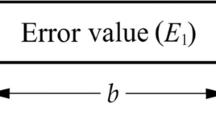Abstract
An adaptive space-time trellis code (STTC) decoder with thesecond-order LMS (SOLMS) based channel tracking is studied in thispaper. We first show that per-survivor processing (PSP) can beadopted as the approximation of the adaptive maximum likelihoodsequence detection (MLSD) of STTC when there are no periodicallyinserted orthogonal pilot sequences (PIOPS). With thispresupposition, we propose a new decoder for STTC, called SOLMSbased PSP decoder, in which we use min-max optimum SOLMSalgorithm for channel tracking when some ``boundary'' statisticalknowledge of the fading channel is available. Intensive computersimulations have been done to compare the performance of theproposed decoder with other known decoding methods as applied tolong burst transmissions.
Similar content being viewed by others
References
A. Naguib, V. Tarokh, N. Seshadri and A.R. Calderbank, “A Space-Time Coding Modem for High-Data-Rate Wireless Communications”, IEEE J.S.A.C., Vol. SAC-16, No. 8, pp. 1459-1478, 1998.
E. Talatar, “Capacity of Multi-Antenna Gaussian Channels”, AT&T-Bell Labs, Internal Tech. Memo., BL011217-950615-07TM, June 1995.
G.J. Foschini and M.J. Gans, “On Limits of Wireless Communication in a Fading Environment when Using Multiple Antennas”, Wireless Personal Communications, Vol. 6, pp. 311-335, 1998.
E. Biglieri, J. Proakis and S. Shamai, “Fading Channels: Information-Theoretic and Communications Aspects”, IEEE Trans. Info. Theory, Vol. IT-44, No. 6, pp. 2619-2692, 1998.
V. Tarokh, N. Seshadri and A.R. Calderbank, “Space-Time Codes for High Data Rate Wireless Communication: Performance Criterion and Code Construction”, IEEE Trans. Info. Theory, Vol. IT-44, No. 2, pp. 744-765, 1998.
V. Tarokh, A. Naguib, N. Seshadri and A.R. Calderbank, “Space-Time Codes for High Data Rate Wireless Communication: Performance Criteria in the Presence of Channel Estimation Errors, Mobility and Multiple Paths”, IEEE Trans. COM., Vol. COM-47, No. 2, pp. 199–207, 1999.
R. Raheli, A. Polydoros and Ching-Kae Tzou, “Per-Survivor Processing: A General Approach to MLSE in Uncertain Environments”, IEEE Trans. COM., Vol. COM-43, pp. 354-364, 1998.
S. Gazor, “Prediction in LMS-Type Algorithm for Smoothly Time Varying Environments”, IEEE Trans. Signal Process., Vol. SP-47, No. 6, pp. 1735-1739, 1999.
K. Shahtalebi, S. Gazor, S. Pasupathy and P.G. Gulak, “Second-Order H? Optimal LMS and NLMS Algorithm Based on a Second-Order Markov Model”, IEE Proc.-Vis. Image Signal Process., Vol. 147, No. 3, pp. 231-237, 2000.
Yisheng Xue and Xuelong Zhu, “PSP Decoding for Space-Time Trellis Code”, in IEEE APCCAS'2000, Tianjin, P.R. China, 2000, pp. 783-786.
K.M. Chugg, “The Condition for the Application of Viterbi Algorithm with Implication in Fading Channel MLSD”, IEEE Trans. COM., Vol. COM-46, No. 9, pp. 1112-1116, 1998.
D.P. Taylor, G.M. Vitetta, B.D. Hart and A. Mammela, “Wireless Channel Equalization”, Euro. Trans. Telecommun., Vol. 9, pp. 117-143, 1998.
Jindong Lin, J.G. Proakis, Fuyun Ling and H. Lev-Ari, “Optimal Tracking of Time-Varying Channels: A Frequency Domain Approach for Known and New Algorithms”, IEEE J.S.A.C.,Vol. SAC-13, No. 1, pp. 141- 154, 1995.
T.S. Rappaport, Wireless Communication Principles and Practice, Publishing House of Electronics Industry: Beijing, 1996.
J.I. Smith, “A Computer Generated Multipath Fading Simulation for Mobile Radio”, IEEE Trans. Vehicular Technology, Vol. VT-24, pp. 39-40, 1975.
Yisheng Xue and Xuelong Zhu, “Second-Order LMS Based Wireless Channel Tracking: Transient State Performance Study and Optimum Design for Short Burst Transmission”, Signal Processing, Aug., 2001, submitted.
M.E. Rollins and S.J. Simons, “Simplified Per-Survivor Kalman Processing in Fast Frequency-Selective Fading Channels”, IEEE Trans. Commun., Vol. COM-45, No. 5, pp. 544-553, 1997.
G. Paparisto and K.M. Chugg, “PSP Array Processing for Multipath Fading Channels”, IEEE Trans. Commun., Vol. COM-47, No. 4, pp. 504-507, 1999.
Author information
Authors and Affiliations
Rights and permissions
About this article
Cite this article
Xue, Y., Zhu, X. Second-Order LMS Based Per-Survivor Processing Decoder for Space-Time Trellis Code. Wireless Personal Communications 25, 223–239 (2003). https://doi.org/10.1023/A:1024027610218
Issue Date:
DOI: https://doi.org/10.1023/A:1024027610218




